Loading Plain Paper / Photo Paper in the Rear Tray
You can load plain paper or photo paper.
You can also load envelopes in the rear tray.
 If you cut plain paper to a size of 5" x 7" (13 x 18 cm) or smaller to perform a trial print, it may cause a paper jam.
If you cut plain paper to a size of 5" x 7" (13 x 18 cm) or smaller to perform a trial print, it may cause a paper jam.
 We recommend Canon genuine photo paper for printing photos.
We recommend Canon genuine photo paper for printing photos.
 You can use general copy paper or Canon Red Label Superior WOP111 / Canon Océ Office Colour Paper SAT213.
You can use general copy paper or Canon Red Label Superior WOP111 / Canon Océ Office Colour Paper SAT213.
 For the page size and paper weight you can use for this printer, see Supported Media Types.
For the page size and paper weight you can use for this printer, see Supported Media Types.
-
Align the edges of the paper. If the paper is curled, flatten it.
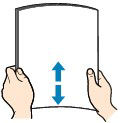
 Align the edges of paper neatly before loading. Loading paper without aligning the edges may cause paper jams.
Align the edges of paper neatly before loading. Loading paper without aligning the edges may cause paper jams.
 If paper is curled, hold the curled corners and gently bend them in the opposite direction until the paper becomes completely flat.
If paper is curled, hold the curled corners and gently bend them in the opposite direction until the paper becomes completely flat.
 When using Photo Paper Plus Semi-gloss SG-201, even if the sheet is curled, load one sheet at a time as it is. If you roll up this paper to flatten, this may cause cracks on the surface of the paper and reduce the print quality.
When using Photo Paper Plus Semi-gloss SG-201, even if the sheet is curled, load one sheet at a time as it is. If you roll up this paper to flatten, this may cause cracks on the surface of the paper and reduce the print quality.
-
Open the rear tray cover (A) and then pull up the paper support (B).
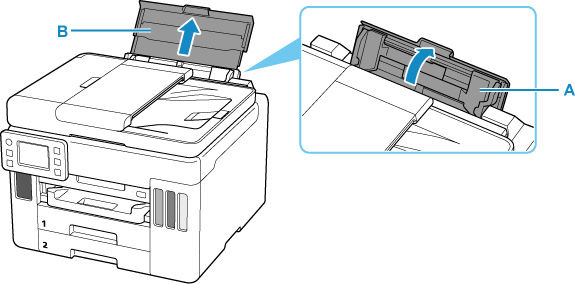
 Load long-length paper without pulling out the paper support. Depending on the weight of the paper, the leading edge may rise and printing may be shifted. Make sure that the leading edge of the paper doesn't rise, such as by holding the part that protrudes from the rear tray.
Load long-length paper without pulling out the paper support. Depending on the weight of the paper, the leading edge may rise and printing may be shifted. Make sure that the leading edge of the paper doesn't rise, such as by holding the part that protrudes from the rear tray.
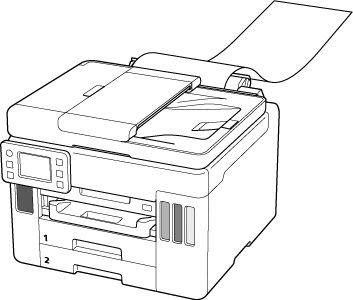
-
Slide the right paper guide (C) to open both paper guides.
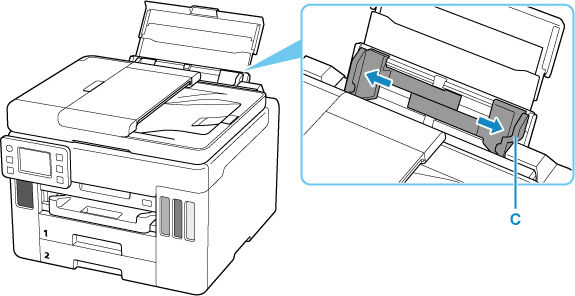
-
Load the paper stack in portrait orientation WITH THE PRINT SIDE FACING UP.
After loading the paper, the paper setting confirmation screen for the rear tray appears on the touch screen.
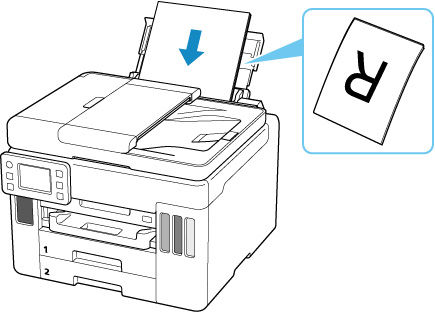
-
Slide the right paper guide to align with both sides of the paper stack.
Don't slide the paper guides too hard against the paper. The paper may not be fed properly.
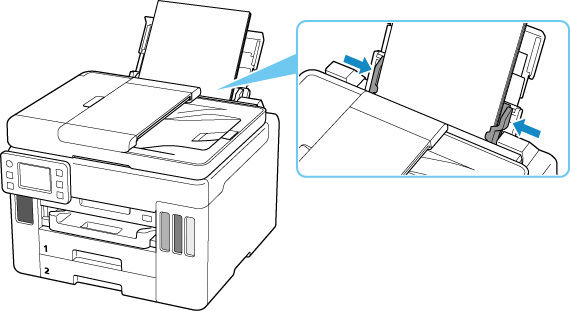
 Always load paper in portrait orientation (D). Loading paper in landscape orientation (E) can cause paper jams.
Always load paper in portrait orientation (D). Loading paper in landscape orientation (E) can cause paper jams.
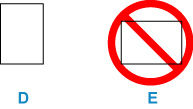
 Don't load sheets of paper higher than the load limit mark (F).
Don't load sheets of paper higher than the load limit mark (F).
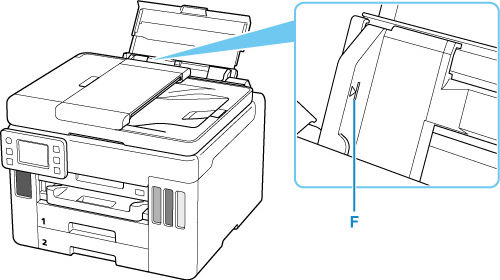
-
If the page size and media type on the touch screen match the size and type of paper loaded in the rear tray, select Yes.
If not, select Change to change the settings in accordance with the size and type of the loaded paper.
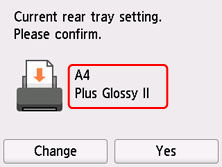
-
Pull out the paper output tray (G).
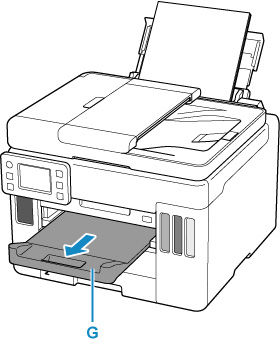
 There are various types of paper, such as paper with a special surface coating for printing photos at optimal quality and paper suitable for documents. Each media type has specific preset settings (how ink is used and sprayed, distance from nozzles, etc.), that allow you to print to that type with optimal image quality. The wrong paper settings may cause poor printout color quality or scratches on the printed surface. If you notice blurring or uneven colors, increase the print quality setting and try printing again.
There are various types of paper, such as paper with a special surface coating for printing photos at optimal quality and paper suitable for documents. Each media type has specific preset settings (how ink is used and sprayed, distance from nozzles, etc.), that allow you to print to that type with optimal image quality. The wrong paper settings may cause poor printout color quality or scratches on the printed surface. If you notice blurring or uneven colors, increase the print quality setting and try printing again.
 To prevent incorrect printing, this printer has a function that detects whether the settings for the paper loaded on the rear tray matches the paper settings. Before printing, make print settings in accordance with the paper settings. When this function is enabled, an error message is displayed if these settings don't match to prevent incorrect printing. When this error message is displayed, check and correct the paper settings.
To prevent incorrect printing, this printer has a function that detects whether the settings for the paper loaded on the rear tray matches the paper settings. Before printing, make print settings in accordance with the paper settings. When this function is enabled, an error message is displayed if these settings don't match to prevent incorrect printing. When this error message is displayed, check and correct the paper settings.
 When printing on long-length paper, support the output paper with your hands or use the printer in a place where the paper doesn't fall. If the paper falls, the printed side may become dirty or scratched. Also, when supporting the paper with hands, be sure not to pull the paper forcefully while printing.
When printing on long-length paper, support the output paper with your hands or use the printer in a place where the paper doesn't fall. If the paper falls, the printed side may become dirty or scratched. Also, when supporting the paper with hands, be sure not to pull the paper forcefully while printing.
If your product issue was not resolved after following the steps above, or if you require additional help, please create or log in to your Canon Account to see your technical support options.
Or if you still need help, visit our Canon Community by clicking the button below to get answers:
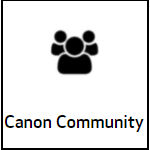
____________________________________________________________________________________________



